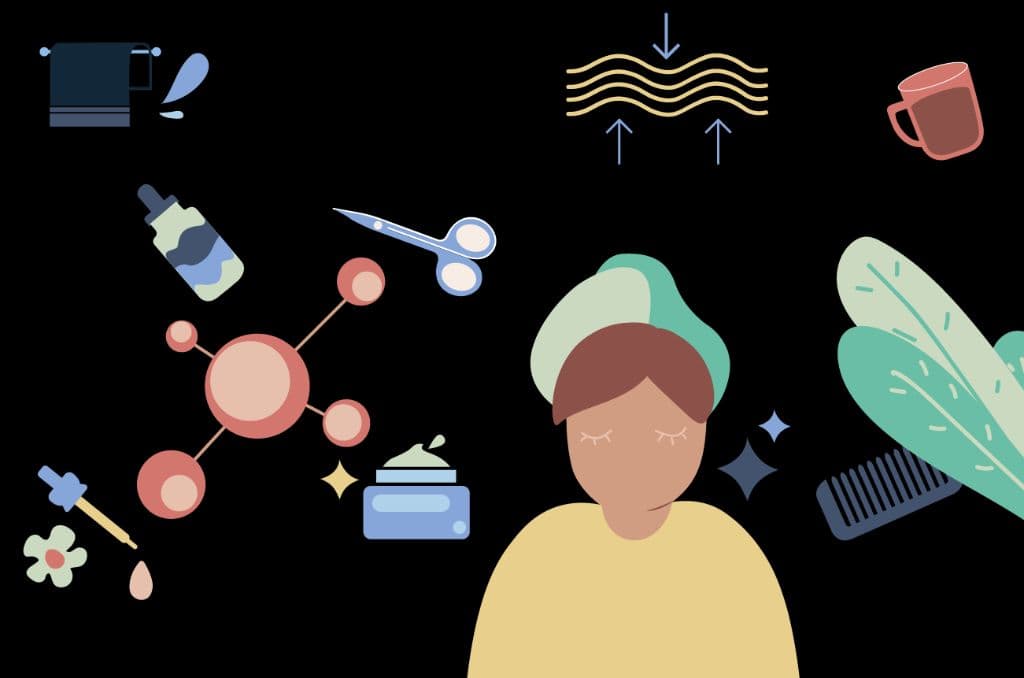This article is compiled by Sanjana Varma, a freelance writer at Proactive For Her.
What is skin pigmentation and why does it happen?
The deepening of the colour of a region of skin is known as hyperpigmentation. This can occur on the face or any other part of the body. Depending on how deep in the skin it is, it could be light to dark brown, grey, blue or blackish in appearance. A Wood's lamp examination is a method of examining the skin with a UV light which helps us to understand the level of pigment in the skin, whether it’s superficial or deep.
The melanin in the skin determines the amount of UV radiation that the body may absorb. Excessive exposure to sunlight causes the skin to darken. People of various backgrounds, skin colours, and ages are affected by skin pigmentation. Skin pigmentation is the darkening of the skin as a result of extensive sun exposure.
What are the types of skin pigmentation and their causes?
1. Melasma: It is a pigmentation that appears on the cheeks, forehead, and nose. Melasma is more common in women and is more common in Indian skin types. Melasma is assumed to be induced in the majority of cases by pregnancy, hormonal drugs such as contraceptive pills, and other conditions associated with hormonal imbalance.
2. Lentigines: Also known as liver spots are benign lesions that develop on the body's sun-exposed parts. Common places are the backs of hands, feet and the face. The number of lesions increases with age, making them more common in middle-aged and older people. They can range in size from 0.2 to 2 cm in diameter. These appear in sun-exposed areas.
3. Solar Lentigines: Sunspots, are pigmented spots with a clearly defined boundary that are induced by UV exposure. They are a sign of photoaging. They can appear anywhere on the body and range from light brown to black. Solar Lentigines should be closely watched since they can progress to skin cancer and melanoma.
4. Freckles: They are light brown under-the-skin spots of colour (or pigment). Ephelides is the medical term for them. Freckles are determined by genetic factors.
5. Post-inflammatory pigmentation: Post Inflammatory Hyperpigmentation, or PIH for short, is a reaction to skin damage. Acne, burns, friction, or clinical procedures like chemical peels, dermabrasion or lasers can all cause it. Once the skin has had time to recover, this condition usually goes away on its own. However, the length of time depends on the severity of the inflammatory response in the skin. PIH usually responds to topical treatments, however, it can reoccur if harsh treatments are used. While it is commonly thought to be a transient phenomenon, it can be more strong and linger longer in people with a darker complexion.
6. Frictional pigmentation: It is a darkening of the skin folds in the neck, armpits, and thighs which could be caused by hormonal changes, weight increase, or friction.
7. Nutritional deficiencies: Inadequate vitamin intake can cause certain pigmentation patterns around the mouth, around the eyes, and on the knuckles.
8. Hypopigmentation: Because there is an abnormally low quantity of melanin in hypopigmented skin, it is lighter in hue. Hypopigmentation can be caused by a variety of factors, including burns, blisters, ulcers, chemical exposure, or infection which have caused skin injuries in the past. Psoriasis and eczema are examples of inflammatory skin disorders (atopic dermatitis) which may sometimes heal with hypopigmentation.
9. Depigmentation: When your skin loses all of its colours and turns white, this is known as depigmentation. Albinism, which is caused by an absence of a melanin-producing enzyme, is a rare hereditary disorder. Vitiligo, an autoimmune disease that develops smooth, white areas on the skin, is a common cause of depigmentation which is treatable.
10. Other diseases: Pigmentation is seen in persons with Addison's illness, Cushing's Syndrome, and thyroid abnormalities, among other ailments.
Why does pigmentation happen?
Pigmentation is determined by:
Melanin: Melanin is produced by special cells in the outer layer of your skin called melanocytes, and it is responsible for your skin tone. Melanosomes are organelles (or mini-organs) found inside these unique skin cells. The amount, size, and functioning of these small melanin factories determine the colour of your skin. Eumelanin (brown and black) and pheomelanin(yellow and red) are the two main forms of melanin. The balance of various forms of melanin in your skin determines your skin colour. This depends on genetics and racial factors.
Genetics: Over 125 genes and various hormones have been linked to skin pigmentation. They can alter the amount of eumelanin or pheomelanin produced by your skin cells, as well as how well they survive and function, resulting in colour alterations over time. The increase and transport of melanosomes, the organelles that carry melanin, is involved in hyperpigmentation and tanning. This is why you can't lighten "darker" skin, although a tan or hyperpigmentation can be lightened.
How to treat skin pigmentation
- Sunscreen is a must: Those seeking therapy for skin darkening should apply broad-spectrum SPF50 sunscreen before leaving the house 365 days a year, and reapply every couple of hours if they plan to spend time outside or near a window in the Spring and Summer. If you plan to be outside during high UV radiation times, such as between noon and 2 p.m., wear a hat with a wide brim or full-sleeved clothes or white clothes because they reflect the sun rays.
- Get to the root of the trouble: Seek the help of your doctor and try to find the underlying cause of your hyperpigmentation and start treatment. It can be the side-effect of your contraceptive or a symptom of some other condition. If recommended, check for any deficiency or hormonal imbalance.
- Antioxidants: Your body needs sunscreen inside too. Antioxidants are the perfect way to treat your body from the inside so they are called oral sunscreens. Take Vitamin C and Vitamin E supplements if cleared by your doctor. It is a way to treat your skin pigmentation naturally.
- Peripheral treatment: Your skin needs love from the outside and inside.
Look for creams and ointments with any of the following:
- Arbutin
- Kojic acid
- Glycolic acid
- Brightenyl
- Lactic acid
- Niacinamide
- Vitamin C
- Vitamin E
- Retinol
- Botanical extracts
5. In-clinic treatments: Your dermatologist may recommend chemical peels, lasers, intense pulse light or stem cell treatments depending on your condition. It is done in the hospital or clinic and you may need to take extra care of your skin for a few days after the treatment to prevent flare-ups.
6. Oral tranexamic acid: The addition of oral tranexamic acid to the therapy of melasma results in long-lasting improvement.
Home remedies to treat pigmentation naturally:
These are some ways to treat skin darkening naturally in the comfort of your home:
- Aloe vera contains aloin, a natural depigmenting ingredient that has been demonstrated to lighten skin and may serve as a nontoxic hyperpigmentation therapy. Apply pure aloe vera gel on pigmented areas at night. Rinse with warm water the next day. Repeat regularly until you achieve the desired result.
- Some commercially available skin and scar-lightening lotions contain red onion (Allium cepa) extract. The dried peel of red onions has been shown to successfully lighten skin in studies. Look for Allium cepa in hyperpigmentation creams and apply as advised.
- Milk, buttermilk, and even sour milk have all been demonstrated to reduce skin discolouration. Lactic acid is the active component that causes this action.
In a glass of milk, soak a cotton ball. Apply it once a day after sunset.
- Lycopene-rich tomato paste protects the skin from both short- and long-term UV damage. You may apply tomato paste on the affected area until you see the results.
- Use mild or gentle products. Check the ingredients before you use them. Go for dermatologically tested products or paraben-free products.
- Eat lots of fruits and vegetables. Treatment begins from the inside. Treat yourself to antioxidant-rich fruits and vegetables to improve your skin health and strengthen your skin defence.
Trust the process
Topical treatments including hydroquinone lotion, chemical peels, dermabrasion, light or laser therapy, and cryotherapy can all be used to reduce skin darkening. However, some procedures, like laser resurfacing need to be performed with caution for those with darker skin types.
If you've developed darker skin patches as a result of pregnancy, talk to your doctor about how to deal with them. Sunscreen and sun-blocking clothes can help to keep the condition from getting worse, and it may diminish on its own after you give birth. If not, prescription and over-the-counter lotions may be able to help you restore your skin tone.
If sections of your skin are lighter owing to skin injury, the only therapy you'll need is time and patience while your skin heals. Meanwhile, cosmetics can help you achieve a more even skin tone.
Consult a dermatologist if you have a chronic skin condition to identify the best treatment option for you. Any change in skin tone might be alarming or distressing. It's natural to feel concerned, ashamed, or frustrated about having to cope with skin damage or a chronic skin condition that causes you to change your look. Certain conditions which cause hypopigmentation and are not easy to treat, ask your doctor to suggest a professional camouflage system for coverage while you wait for the treatment to take effect. If you need additional assistance, don't hesitate to contact a doctor or therapist. Know that you're not alone and that you can deal by seeking help from others who have had similar experiences.
Disclaimer: This information is provided for educational purposes and should not be construed as medical advice. Please consult with your healthcare practitioners before undertaking any changes in your diet or adding supplements.
Proactive For Her is a digital clinic for women, offering accessible, personalized, and confidential healthcare solutions. We offer products and services for out-patient health concerns of Indian women, across their lifetime - from puberty to pregnancy to menopause. To know more on the sexual and reproductive health of women, visit https://www.proactiveforher.com/

